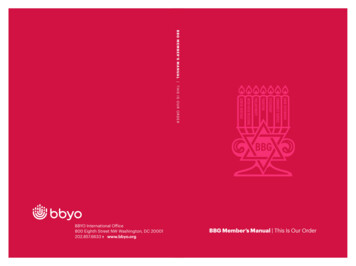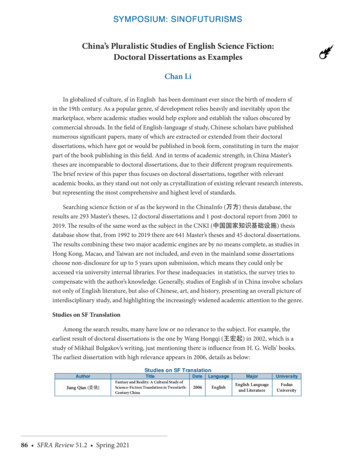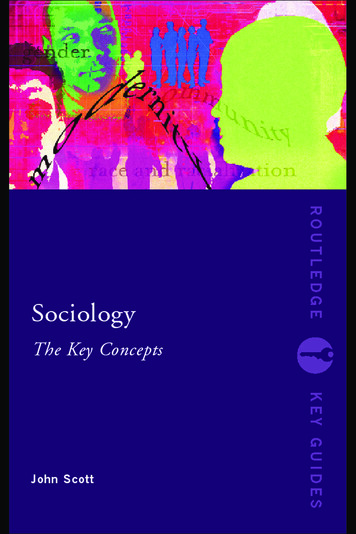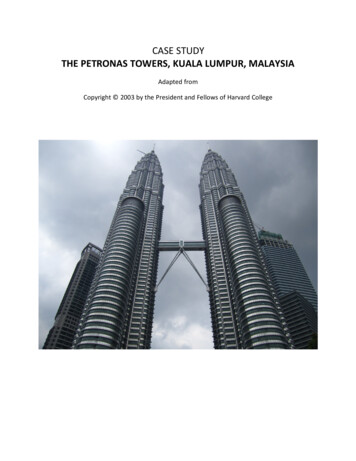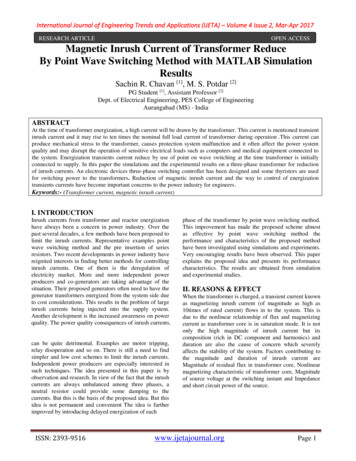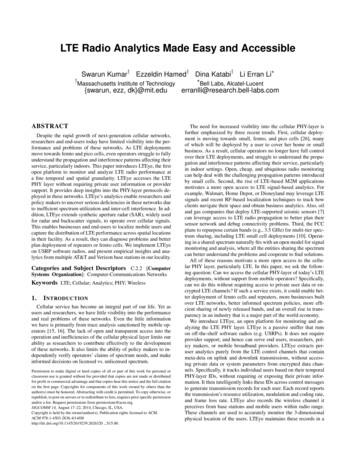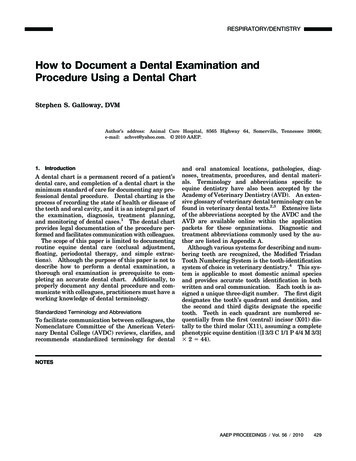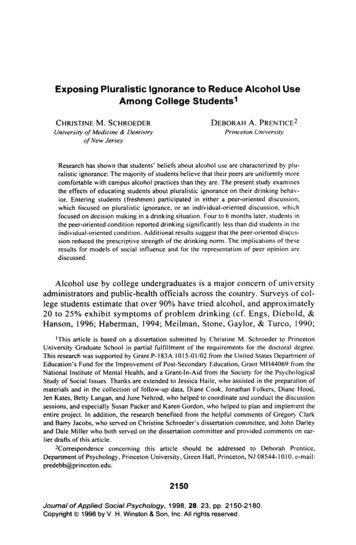
Transcription
Exposing Pluralistic Ignorance to Reduce Alcohol UseAmong College Students’CHRISTINE M. SCHROEDERUniversity ofhfedicine & Dentistryof N e w JerseyDEBORAHA. P R E N T I C E Princeton UniversityResearch has shown that students’ beliefs about alcohol use are characterized by pluralistic ignorance: The majority of students believe that their peers are uniformly morecomfortable with campus alcohol practices than they are. The present study examinesthe effects of educating students about pluralistic ignorance on their drinking behavior. Entering students (freshmen) participated in either a peer-oriented discussion,which focused on pluralistic ignorance, or an individual-oriented discussion, whichfocused on decision making in a drinking situation. Four to 6 months later, students inthe peer-oriented condition reported drinking significantly less than did students in theindividual-oriented condition. Additional results suggest that the peer-oriented discussion reduced the prescriptive strength of the drinking norm. The implications of theseresults for models of social influence and for the representation of peer opinion arediscussed.Alcohol use by college undergraduates is a major concern of universityadministrators and public-health officials across the country. Surveys of college students estimate that over 90% have tried alcohol, and approximately20 to 25% exhibit symptoms of problem drinking (cf. Engs, Diebold, &Hanson, 1996; Haberman, 1994; Meilman, Stone, Gaylor, & Turco, 1990;‘This article is based on a dissertation submitted by Christine M. Schroeder to PrincetonUniversity Graduate School in partial fulfillment of the requirements for the doctoral degree.This research was supported by Grant P- I83A 1015-0 1/02 from the United States Department ofEducation’s Fund for the Improvement of Post-Secondary Education, Grant MH44069 from theNational Institute of Mental Health, and a Grant-In-Aid from the Society for the PsychologicalStudy of Social Issues. Thanks are extended to Jessica Haile, who assisted in the preparation ofmaterials and in the collection of follow-up data, Diane Cook. Jonathan Folkers, Diane Hood,Jen Kates, Betty Langan, and June Nehrod, who helped to coordinate and conduct the discussionsessions, and especially Susan Packer and Karen Gordon, who helped to plan and implement theentire project. In addition, the research benefited from the helpful comments of Gregory Clarkand Barry Jacobs, who served on Christine Schroeder’s dissertation committee, and John Darleyand Dale Miller who both served on the dissertation committee and provided comments on earlier drafts of this article.’Correspondence concerning this article should be addressed to Deborah Prentice,Department of Psychology. Princeton University, Green Hall, Princeton, NJ 08544-1 01 0. e-mail:predebb@princeton.edu.JoumalofApplied Social Psychology, 1998, 28, 23,pp. 2150-2180.Copyright 0 1998 by V. H. Winston 8 Son, Inc. All rights reserved.
PLURALISTIC IGNORANCE2151Perkins & Berkowitz, 1989; see Berkowitz & Perkins, 1986; and Prendergast,1994, for reviews). Alcohol and alcohol-related events are cited as the number-one cause of death among young people in the United States, primarilybecause of alcohol-related car accidents and the role that alcohol plays in suicide (Thorner, 1986). In addition, heavy drinking among college students isassociated with lower academic performance, a higher rate of getting intotrouble with authorities, disruptions in personal relationships, and, for malestudents, an increased risk of fighting or of damaging property (Berkowitz &Perkins, 1986).Social Influence and Alcohol UseThere is now considerable evidence to suggest that social processes play apowerful role in promoting drinking among college students. In particular,numerous studies have shown that one of the most consistent predictors of anadolescent’s alcohol use is perceived alcohol use by his or her peers (e.g.,Ellickson & Bell, 1990; Kandel, 1980; Marks, Graham, & Hansen, 1992;Perkins, 1985; Stein, Newcomb, & Bentler, 1987). For example, in a reviewof the literature on alcohol and other drug use, Kandel found that the extent ofperceived drug use in the peer group, self-reported drug use by peers, andperceived tolerance for use were all strong predictors of an adolescent’s owndrug use (Orford, 1985). More recently, Mooney and Corcoran ( 1991) foundthat perceived peer alcohol consumption and attitude predicted variance inalcohol consumption beyond that attributable to personal characteristics.Similarly, Werner, Walker, and Greene (1996) found that students’ impressions of their friends’ drinking correlated with concurrent and future risk forproblem drinking. These and many similar findings have been taken as evidence that perceptions of peers exert a considerable influence on adolescents’drinking behavior, even though few of the studies have directly addressed thequestion of causality (Kandel, 1980).Peer influence in and of itself is not sufficient to explain why college students tend toward high levels of alcohol consumption. Presumably, peerscould as easily encourage moderation as excess. However, on most collegecampuses, peer influence is directed by injunctive norms that promote heavyalcohol use (Perkins & Berkowitz, 1986; Prentice & Miller, 1993). Indeed,drinking, sometimes to excess, is central to the social identity of many college students and is an important part of social life on most campuses. Thus,it is not surprising that the move to college produces an increase in alcoholconsumption, especially among students with little previous experience withalcohol (Friend & Koushki, 1984; Hill & Bugen, 1979; Perkins, 1985;Wechsler & McFadden, 1979). Further evidence suggests that a normative
2152 SCHROEDER AND PRENTICEfrequency of binge drinking (neither too often nor too seldom) is associatedwith greater intimacy and higher levels of disclosure in peer relations(Nezlek, Pilkington, & Bilbro, 1994). These findings are precisely what onewould expect if students’ alcohol use was driven by social influence processes. They reflect pressures toward increasingly uniform and normconsistent behaviors over time (for similar examples in other domains, seeCrandall, 1988; Festinger, Schachter, & Back, 1950; Newcomb, 1943).Pluralistic IgnoranceThis emerging picture of the ways in which social influence processespromote alcohol use among college undergraduates would not be completewithout one additional fact about the norm for drinking on campus: It doesnot map well onto the private sentiments of individual students. Indeed, eventhough students acknowledge the liberal drinking norm and often conform toit in their outward behavior, they still harbor considerable misgivings aboutthe safety, wisdom, and desirability of drinking. The norm that guides theirpublic behavior does not enjoy their private support. If students were awareof this disjunction between the behavioral norm and private attitudes, presumably the norm would lose its prescriptive force. However, students areaware of this disjunction only in their own cases: They assume that theirpeers hold private views that are much more consistent with the drinkingnorm than are their own.In short, students’ beliefs about alcohol use on campus are characterizedby pluralistic ignorance: They assume that their own private attitudes aremore conservative than are those of other students, even though their publicbehavior is identical (Miller & McFarland, 1991). Numerous studies havedocumented this systematic divergence of students’ own attitudes about alcohol practices from their assumptions about the attitudes of their peers. Forexample, Prentice and Miller (1 993) found that a cross-section of studentssampled from all four college classes (i.e., freshman through senior years)rated themselves as less comfortable than the average student and as lesscomfortable than their friends with drinking on campus. In addition, students’estimates of others’ attitudes were characterized by an illusion of universality(Allport, 1924): Not only did they overestimate their peers’ support for thedrinking norm, they overestimated the uniformity of that support (Prentice &Miller, 1993). Perkins and Berkowitz (1986) also found a sizable disparitybetween students’ own attitudes toward alcohol use and their assessments ofthe general campus attitude. These researchers asked students to select fromamong five statements the one that best represented their own feelings aboutdrinking and the one that best represented “the general campus attitude
PLURALISTIC IGNORANCE2153toward drinking alcoholic beverages” (p. 964). Almost two thirds of theirsample endorsed the moderate statement, “An occasional ‘drunk’ is okay aslong as it doesn’t interfere with grades or responsibilities,” and less than 20%endorsed the two more permissive statements. By contrast, over 60% selectedone of those two more permissive statements as representing the campus attitude toward drinking.These findings reveal that students’ perceptions of their peers’ attitudesare in error. They exaggerate the extent to which other students are comfortable with excessive drinking. Ironically, it appears that this misperceptionmay play a role in maintaining the pro-alcohol norm on campus. Prentice andMiller (1993), for example, found evidence for attitudinal conformity amongmale students, who modified their private attitudes over time in the directionof the position they mistakenly assumed to be held by the average student. Ina separate study, Prentice and Miller also found that both male and femalestudents showed signs of alienation from the university and from their peerswhen they (mistakenly) believed their attitudes to be discrepant from those ofthe average student. And as we noted earlier, previous research on substanceuse has shown that the perceived level of tolerance for alcohol and drug useamong peers is a strong predictor of one’s own use (Kandel, 1980). It is clearthat perceptions of peer opinion, even if erroneous, have significant consequences.Changing Drinking BehaviorThus, considerable evidence suggests that pluralistic ignorance plays avery negative role in campus social life, perpetuating dysfbnctional drinkingnorms and engendering alienation within the campus community. At thesame time, pluralistic ignorance has one positive feature: It offers a clearroute to behavior change. If students’ drinking practices are fostered, or atleast maintained, by the erroneous perception that other students feel morepositively toward these practices than they do, then correcting this misperception should lower their alcohol consumption. Most attempts to promoteresponsible drinking on college campuses have taken the form of informational programs, designed to convey legal and pharmacological informationabout the effects of alcohol (Berkowitz & Perkins, 1987). More sophisticatedprograms have sought to teach individual students to make responsible decisions about alcohol and alcohol consumption in drinking situations (e.g.,Meacci, 1990). Yet, until recently, attempts at alcohol intervention havefocused on changing individual students’ beliefs and attitudes about alcoholand have ignored the social context in which most drinking on college campuses takes place (see Donaldson, Graham, Piccinin, & Hansen, 1995;
2154 SCHROEDER AND PRENTICEEllickson, Bell, & McGuigan, 1993; and MacKinnon et al., 1991, for somenotable exceptions using pre-college-age populations).We wish to argue that a more effective way to change students’ drinkingbehavior would focus instead on revealing their erroneous assumptions aboutthe attitudes of their peers. Previous studies have shown that the majority ofstudents already hold the moderate attitudes toward drinking that informational campaigns and individual counseling sessions seek to foster (Perkins &Berkowitz, 1986; Prentice & Miller, 1993). What students need, in addition,is to understand that those attitudes are shared. We contend that if studentswere made aware that their estimates of other students’ attitudes were too liberal-that is, if they were exposed to the concept of pluralistic ignorance in agroup setting-then they should experience much less social pressure to consume alcohol. As a result, they should drink less and should feel more comfortable with their drinking behavior.Exposing pluralistic ignorance could change drinking behavior in at leasttwo ways. First, it could change the level of drinking that students perceive tobe condoned by their peers. Given the news that their peers are not as comfortable with current drinking practices as they had thought, students mightconstruct a new, more conservative norm for drinking; one that correspondsto true campus sentiment. This change in the level of drinking prescribed bythe norm would produce changes in drinking behavior. Students would stillexperience social pressure to drink, but the level of drinking they felt pressured to achieve would be lower, more in line with their private sentiments,and would have much less deleterious consequences.Alternatively, exposing pluralistic ignorance could change drinkingbehavior by changing the prescriptive strength of the norm. Social normsderive much of their prescriptive power from the perception that they haveuniversal support (Turner, 1991). Indeed, the presence of even one alternativeviewpoint in a group sharply reduces the power of the group norm to induceconformity (e.g., Asch, 195 1). Providing students with evidence that theirpeers are not entirely comfortable with current drinking practices would certainly indicate to them that support for the drinking norm is less universalthan they may have supposed, and thus should weaken the norm’s prescriptive power. This change in the strength of the norm would produce changes indrinking behavior. Students would no longer feel the same degree of socialpressure to bring their own alcohol use into line with the campus standard.It is important to note that the drinking norm to which we refer in thisanalysis is an injunctive norm, not a descriptive norm (Cialdini, Kallgren, &Reno, 1991). Descriptive norms are defined by what individuals do;injunctive norms are defined by what they approve (or disapprove) of doing.The drinking norms that drive pluralistic ignorance are defined by what
PLURALISTIC IGNORANCE2155college students think is appropriate and good behavior, rather than what theythink is common behavior. The discrepancy that we find between students’own comfort with campus alcohol practices and their perceptions of the average student’s comfort represents a misperception of how other students feelabout drinking (the injunctive norm), rather than of how much they drink (thedescriptive norm). Interestingly, researchers have documented a similar misperception of the descriptive drinking norm (Baer & Carney, 1993; Baer,Stacy, & Larimer, 1991), but that finding is not directly relevant to this investigation.Present StudyThe research reported in this article was designed to explore the behavioraland psychological consequences of correcting students’ misperceptions oftheir peers’ attitudes toward drinking. Entering students were randomlyassigned to participate in one of two types of discussions about alcohol useduring their first week on campus. In the peer-oriented condition, studentswere introduced to the data showing systematic misperception of other students’ comfort with campus drinking practices, and were encouraged to talkabout this phenomenon and the social dynamics surrounding drinking moregenerally. In the individual-oriented condition, students participated in a discussion of how to make responsible personal decisions in a drinking situation.This latter condition served as a control, from which to evaluate the effects ofthe peer-oriented discussion;3 it was chosen as the comparison because it wasrepresentative of many existing programs designed to change drinking behavior. Four to 6 months after the discussions, all students completed self-reportmeasures of their alcohol consumption. We expected to find lower levels ofreported alcohol consumption among students in the peer-oriented conditionthan among students in the individual-oriented condition.In addition to demonstrating the effects of dispelling pluralistic ignorance,we were also interested in understanding the psychological mechanismsunderlying these effects. Thus, we included several additional measuresdesigned to shed some light on why exposure to evidence of pluralistic ignorance might reduce students’ alcohol consumption. First, we asked all participants to rate their own comfort with alcohol use and the comfort of theaverage student, both directly before the discussion sessions and at the time3For research purposes, we would have liked to include a no-treatment control group in thedesign. However, ethical considerations argued against a no-treatment control. In particular, university officials felt very strongly that it was not appropriate to offer some students an opportunity to participate in a discussion group with potential benefits without offering somethingcomparable (and also potentially beneficial) to other students.
2156 SCHROEDER AND PRENTICEof the follow-up. If dispelling pluralistic ignorance reduces drinking bychanging the level of drinking prescribed by the norm, then we would expectthe condition difference in drinking to be mirrored by a condition differencein the comfort attributed to the average student, and significant, uniform correlations between these two measures across conditions. Second, immediately following the discussion sessions, we asked all participants to completethe short form of Watson and Friend’s (1969) Fear of Negative EvaluationScale (Leary. 1983). This scale assesses the extent to which people are characteristically anxious about others’ evaluations of them and fearful of a lossof social approval. We intended it to serve as a measure of the extent to whichstudents were sensitive to normative social influence. If dispelling pluralisticignorance reduces drinking by reducing the strength of the norm, then theeffects of this manipulation should be greatest for those students who aremost sensitive to, and thus most influenced by, social pressure. We expectedthat fear of negative evaluation might moderate differences between the individual-oriented and peer-oriented conditions.MethodOverviewFirst-year students participated in one of two types of discussion groupsabout alcohol use during their second week on campus. Brief questionnairesadministered immediately before and after the discussions tapped students’demographic characteristics, attitudes and beliefs about alcohol use on campus, and fear of negative evaluation. Four to 6 months later, a subsample ofthe participants completed a third questionnaire that again assessed their attitudes and beliefs about alcohol use on campus and also included questionsabout their own drinking behavior.Participants and DesignPrinceton University has five residential colleges that provide housing forvirtually all first- and second-year students. Within each residential college,first-year students are divided into residential advisor (RA) groups that rangein size from 12 to 20 students. The RA groups in four of the five residentialcolleges were invited to participate in this study as one of a series of activitiesdesigned to orient them to campus life.4 A total of 452 first-year studentsattended one of the September discussion sessions with their RA group. This4The failure of one residential college to participate in the study was due to administrativeand staffing difficulties that do not bear in any way on the interpretation of the results.
PLURALISTIC IGNORANCE 2157sample included approximately half of the students who were eligible toattend the discussions; it was representative of the first-year class in terms ofall demographic categories for which class statistics were available (gender,ethnicity, and varsity athlete status). The discussions took place during thefirst week of classes on 3 successive nights in the residential colleges. Eachcollege had two 1-hr discussions each evening, and each discussion wasattended by the members of two RA groups.We chose to conduct this study with entering students for two reasons.First, they did not already have well-established drinking patterns within thelocal environment. Having just arrived on campus, they did not yet knowwho their friends would be, how they would spend their evenings and weekends, or what role alcohol use would play in their social lives. We anticipatedthat it would be easier to affect the formation of their drinking habits than tochange the already-established habits of more advanced students. Second, theperceptions that entering students had of the campus and their peers were notyet as well entrenched as those of older students. Although they certainlywere not without some beliefs and preconceptions about what college lifewould be like, they had little direct experience with which to back those up.Again, we anticipated that it would be easier to affect their beliefs in the formative stages than to change their way of thinking later on.There were two types of discussions: a peer-oriented discussion and anindividual-oriented discussion. RA groups were systematically assigned todiscussion type so that both types were represented on all 3 nights and in allresidential colleges. This procedure was designed to minimize possible confounds due to scheduling or to different characteristics of the residential colleges. In all, 235 students participated in peer-oriented discussions and 2 17 inindividual-oriented discussions.Four to 6 months after the discussions, 143 of the students completed thefollow-up questionnaire. The representativeness of this subsample wasassessed by comparing students who returned for the follow-up to thosewho did not, on a number of measures. Likelihood of returning for the follow-up did not vary with gender, ethnicity (ethnic groups considered wereAfrican American, Asian American, Caucasian, and Hispanic), or varsityathlete status (all x 2 1). In addition, follow-up participants did not differfrom dropout participants in their self-reported comfort with alcohol use oncampus or in their fear of negative evaluation; separate logistic regressionspredicting return for the follow-up from comfort with alcohol and fear ofnegative evaluation showed no association (both x 1). Finally, and mostimportantly, likelihood of returning for the follow-up did not vary withdiscussion condition, x 2( 1, N 143) 1.93, p .lo. Thus, we could bereasonably certain that the follow-up sample was representative of the*
2158 SCHROEDER AND PRENTICEpopulation of interest and that students were not electing to return for thefollow-up based on their comfort with alcohol, their social anxiety, or thetype of discussion they had attended in September. The final sampleincluded 66 students (35 males, 3 1 females) in the peer-oriented condition,and 77 students (44 males, 33 females) in the individual-oriented condition.The analyses reported in this article include data from only those studentswho participated in all phases of the study.MeasuresPrediscussion questionnaire. At the beginning of the discussion sessions,participants completed a brief questionnaire that assessed their membershipin various demographic groups, their own comfort with alcohol use on campus, and their estimates of the average student’s comfort with alcohol.Students were first asked to indicate their gender, ethnicity, religiousbackground, home state, whether they attended a public or private highschool, whether they were members of a varsity sports team, and the last fourdigits of their Social Security numbers. For purposes of the current research,only gender was of interest. Other demographic data were used to match theinitial questionnaires with the follow-up questionnaire for each participantand to assess the representativeness of the sample.In addition, students were asked to indicate their own comfort with alcohol use on campus and to estimate the comfort of the average student, as inPrentice and Miller (1993). The two questions were as follows:1. How comfortable are you with students’ drinking habits?2. Given what you know about Princeton students, how comfortable do youthink the average Princeton student is with students’ drinking habits?Students responded to each question by circling a number on the corresponding1 1-point scale, ranging from 1 (not at all comfortable) to 1 1 (very comforruble).55We did not include a measure of students’ drinking behavior in this initial assessmentbecause it would not have provided a valid baseline to which to compare later drinking. The discussion sessions were conducted with first-year students in their first week on campus; neitherthe number of drinks they had had in the last week nor the number of drinks they had in a typicalweek would serve as a relevant comparison for their drinking behavior during the upcomingsemester. Thus, we relied on the between-subjects comparison across conditions, rather than thewithin-subjects comparison across time, to assess the effects of the discussion sessions. It isworth noting that the effectiveness of alcohol interventions has been shown to vary with baselinelevels of consumption (e.g., Ellickson et al., 1993). However, because we randomly assignedparticipants to conditions, we had no reason to expect baseline drinking to have a differentialeffect across the two types of discussion groups.
PLURALISTIC IGNORANCE2159Postdiscussion questionnaire. Following the discussions, participants completed a second questionnaire that included questions about their plans fortheir first year at college, their reactions to the discussion groups, and, of particular relevance to the present investigation, their fear of negative evaluation(FNE).FNE was assessed with the short form of Watson and Friend’s ( 1 969)Fear of Negative Evaluation Scale (Leary, 1983). This 12-item index measures the extent to which an individual is characteristically anxious about theevaluations of others. Items include: “I worry about what people will thinkof me even when I know it doesn’t make any difference”; “I am afraid thatothers will not approve of me”; “Other people’s opinions of me do notbother me” (reverse scored). Students indicated their agreement with eachstatement using a 5-point scale ranging from 1 (not ar all like me) to5 (extremely Iike me). Each student’s ratings of the 12 items were summed tocreate a single index of fear of negative evaluation (a .90). Possible scoreson the index ranged from 12 to 60, with higher scores indicating higher levels of fear.Follow-up questionnaire. Approximately 4 to 6 months after the discussions, follow-up participants completed a final questionnaire. They wereasked to indicate their gender and the last four digits of their Social Securitynumbers on the questionnaire so that each student’s responses could bematched with his or her earlier questionnaires.In the follow-up questionnaire, students were again asked to indicatetheir own comfort with students’ drinking habits and the comfort of theaverage student on 1 1 -point scales, as in the prediscussion questionnaire. Inaddition, they were asked a series of standard questions about their ownalcohol consumption. The first two items assessed whether they drankalcohol:1. Have you ever tried alcohol at all?2. Have you consumed alcohol for recreational or social reasons in thepast semester?Students responded to each of these questions by circling Yes or No. Thenext two items assessed how much alcohol they drank, using an open-endedformat:3. How many alcoholic drinks have you had in the past week?4.How many alcoholic drinks do you have in a typical week during thesemester?
2160 SCHROEDER AND PRENTICEStudents estimated their weekly alcohol intake.6ProcedureThe discussion groups were conducted as part of the orientation programfor first-year students. They were led by peer facilitators who were second-,third-, and fourth-year students at the university. The facilitators wererecruited from several existing peer-education programs on campus. Peerfacilitators participated in a 3-hr workshop several days before the discussiongroups began, in which they were trained to lead one of the two types of discussions. Each facilitator led only peer-oriented or individual-oriented discussion groups.The discussions took place in the residential colleges in closed-offlounge areas with TV and VCR equipment. When students arrived, theywere introduced to the project by the peer facilitator and were asked to signan informed consent sheet. They then completed the prediscussion questionnaire.Next, students saw a video presentation that lasted approximately 7 min.The video portrayed several alcohol-related social scenes in a university setting. The video clips were meant to be descriptive, rather than prescriptive;their primary purpose was to provide a basis for the following discussion.After the video, students took part in a 20-min discussion about drinkingon campus. The format was the same for all discussions, but the specific topicvaried by condition. In the individual-oriented condition, the discussion centered on the individual and how he or she makes responsible decisions aboutalcohol consumption. Students were encouraged to reflect on the types of situations in which they might encounter alcohol at the university, to exploretheir options in those situations, and to consider the personal and social consequences of various courses of action. They also talked about the effects ofalcohol and how it might interfere with their decision-making abilities. In the6Although the self-report measure of alcohol consumption that we used in this study is similar to those used in virtually all studies of drinking among adolescents and college
trouble with authorities, disruptions in personal relationships, and, for male students, an increased risk of fighting or of damaging property (Berkowitz & Perkins, 1986). Social Influence and Alcohol Use There is now considerable evidence to suggest that social processes play a powerful role in promoting drinking among college students.



